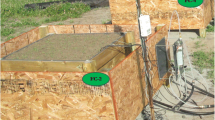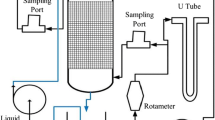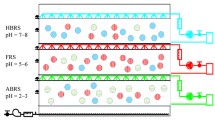Abstract
The capacity of biofilter systems to remove volatile organic compounds in the presence of high concentrations of hydrogen sulfide was investigated for applications in wastewater lift stations. The treatment system was an enclosed unit composed of a biotrickling filter coupled with a biofilter. The biofilter media were plastic hollow spherical balls filled with a compost mixture; and the biotrickling filter media was a structured plastic packing. The gases from the pumping station wet well were a mixture of H2S and low concentration aliphatic and aromatic VOCs, toluene being the most significant in concentrations of 41 ppb. The H2S concentration was 314 ppm with fluctuations of 100 ppm resulting from pumping cycles at the station. No inhibition effect was detected from the simultaneous biological removal of VOCs and H2S: toluene removal efficiency was 91% with the two sections contributing approximately equally to the pollutant removal; and the average removal of H2S was 74%. A traditional open-in-ground biofilter filled with wood chips and compost, existing in the site, attained similar removal efficiencies for toluene, but the elimination capacity of the biotrickling/biofilter system was 3.3-times higher than the open biofilter.







Similar content being viewed by others
References
Abumaizar RJ, Kocher W, Smith EH (1998) Biofiltration of BTEX contaminated air streams using compost-activated carbon filter media. J Hazard Mater 60:111–126
Chitwood DE, Devinny JS, Reynolds FE (1999) Evaluation of a two-stage biofilter for treatment of POTW waste air. Environ Prog 18:212–221
Cooper CD, Alley FC (2002) Air pollution control—a design approach. Waveland Press, IL
Cox HHJ, Deshusses MA (2002a) Co-treatment of H2S and toluene in a biotrickling filter. J Chem Eng 87:101–110
Cox HHJ, Deshusses MA (2002b) Biotrickling filters for air pollution control. J Encycl Environ Microbiol 2:782–795
Cox HHJ, Deshusses MA, Converse B, Schroeder ED, Vosooghi D, Samar P, Iranpour R (2002) Odor and VOC treatment by biotrickling filters: pilot scale studies at the hyperion treatment plant. Water Environ Res 6:557–563
Cox HHJ, Deshusses MA, Converse B, Schroeder ED, Vosooghi D, Samar P, Iranpour R (2003) Odor and VOC removal from wastewater treatment plant headworks ventilation air using a biofilter. Water Environ Res 5:444–454
Delhomenie MC, Bibeau L, Bredin N (2002) Biofiltration of air contaminated with toluene on a compost based bed. Adv Environ Res 6:239–254
Deviny JS, Deshusses MA, Webster TS (1999) Biofiltration for air pollution control. Lewis Publishers, New York
Eldon RR, Murthy DVS, Swaminathan T (2005) Performance evaluation of compost biofilter treating toluene vapors. Proc Biochem 40:2771–2779
Jones KD, Martinez AI, Maroo K, Deshpande S, Boswell J (2002) Kinetic evaluation of H2S and ammonia biofiltration for air emissions control. In: 95th Annual air and water management association conference, Baltimore, MD, 43167
Jones KD, Martinez AI, Rizwan M (2003) Evaluation of sulfur toxicity and media capacity for H2S removal in biofilters packed with both natural and commercial media. In: 96th Annual air and water management association conference, Baltimore, MD, 69751
Lu C, Lin MR, Chu C (2002) Effects of pH, moisture, and flow pattern on trickle bed air biofilter performance for BTEX removal. Adv Environ Res 6:99–106
Martinez AI, Tamara W (2002) High concentration of BTEX removal in compost biofilters. In: AWMA 95th annual conference and exhibition, Baltimore, MD, 42950
Oyarzun P, Arancibia F, Canales C, Aroca GE (2003) Biofiltration of high concentration of hydrogen sulphide using Thiobacillus thioparus. Proc Biochem 39:165–170
Stewart WC, Barton TA, Thom RR (2000) High VOC loading in biofilters—petroleum and industrial applications. In: 93rd Annual air and water management association conference, Salt lake city, UT
Torres EM, Basrai SS (1998) Evaluation of two biotechnologies—biofiltration and biotrickling filtration for controlling air emissions from POTWs. In: AWMA annual meeting, Pittsburgh, PA, 98-MP20A.01
Webster TS, Devinny JS (1996) Biofiltration of odors, toxic and volatile organic compounds from publicly owned treatment works. Environ Prog 15:141–147
Acknowledgments
This material is based upon work supported by the National Science Foundation under Grant No. HDR-0206259 and by the Texas Higher Education Coordinating Board Technology Development and Transfer Program Y04. We gratefully acknowledge the additional in-kind support by BioReaction Industries LLC, the Brownsville Public Utilities Board and help of the personnel of the Robindale Wastewater Treatment Plant of the City of Brownsville, TX, USA.
Author information
Authors and Affiliations
Corresponding author
Rights and permissions
About this article
Cite this article
Martinez, A., Rathibandla, S., Jones, K. et al. Biofiltration of wastewater lift station emissions: evaluation of VOC removal in the presence of H2S. Clean Techn Environ Policy 10, 81–87 (2008). https://doi.org/10.1007/s10098-007-0110-y
Received:
Accepted:
Published:
Issue Date:
DOI: https://doi.org/10.1007/s10098-007-0110-y




